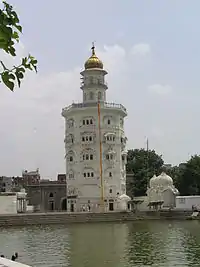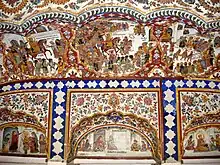| Gurdwara Baba Atal Rai ਗੁਰਦੁਆਰਾ ਬਾਬਾ ਅਟੱਲ | |
|---|---|
 Baba Atal | |
| General information | |
| Architectural style | Sikh architecture |
| Town or city | Amritsar |
| Country | India |
| Completed |
|
Gurdwārā Bābā Aṭṭal Rai (Punjabi pronunciation: [ɡʊɾᵊd̪ʊäːɾäː bäːbäː əʈʈəɭᵊ]) is a famous Gurdwara in Amritsar dedicated to Atal Rai, a son of Guru Hargobind and Mata Nanaki.[1][2][3] It consists of nine-stories and is around forty metres in-height.[3] It is just a short walk from the famous Harmandir Sahib.
Location
The structure is located in the southern direction of the Golden Temple.[3] It is approximately 135 metres away from the Sarai Guru Ram Das building.[3]
Architecture
The building is octagonal in shape, with a double-octagonal structure.[3] One octagonal structure is the bigger of the two and rises externally and the other, smaller one rises internally, with the external one being circumambulatory to the interior one.[3] The accompanying stories of the exterior octagonal structure ceases after the sixth floor, but they continue until the ninth for the interior octagonal structure.[3] The ninth floor is topped off with a golden dome.[3] A double-staircase, using the wall breadth, takes one to the top of the building.[3] At the ground floor, there are four entry doors on each of the main directions.[3] The main entrance of these four entry doors is the one facing in the eastward direction.[3] There is a central room on the ground floor that also has four doors and the Guru Granth Sahib is displayed within this room placed on a brass canopy.[3] The doors of the structure are brass and silver and feature intricate embossed artwork on them.[3] There are various brass plaques, which are embossed, depicting Sikh and Hindu themes throughout the structure.[3] Groupings of three embossed brass plaques are adhered to each of the four exterior doors.[3]
History
Built some four centuries ago, the Baba Atal Gurdwara is a touching commemoration of the young life of Baba Atal Rai (1619–1628), the son of Guru Hargobind.[3] Its nine stories echo his nine years of life before his death in 1628.[4][3] According to Sikh legend narrated in the Gurbilas Chhevin Patshahi, Atal Rai revived a friend named Mohan who was bitten by a snake and subsequently died as a result of the injury.[3] Upon hearing the news of the event, his father was displeased as the performance of miracles is rebuked by the Sikh gurus.[3] After being admonished by his father for the miracle, Atal Rai retired himself to the bank of Kaulsar and died on 13 September 1628 with the aim of leaving this world.[3] His remains were cremated on the bank of Kaulsar.[3] The tower was built in his memory and to commemorate his short life.[1][3] Even though Atal Rai died as a child, he was given the honourific 'baba', usually given to aged and respected men, in commemoration for his spiritual powers.[3]
Initially a small samadhi (Indic cenotaph) was constructed at the site, which eventually transformed into a gurdwara.[3] In India, it is a common practice for the tombs of saintly individuals to be gradually transformed into religious shrines as time goes by.[3] It was during the time of Maharaja Ranjit Singh that the present-day, nine-story tower was constructed.[5] However, Kanwarjit Singh Kang believes the present-day tower had been erected between circa 1775–1800 (last quarter of the 18th century).[3] Repairs, extensions, and renovations to the structure were conducted in the coming years from time-to-time.[3] The first two stories of the tower were constructed under the purview and direction of Jodh Singh Ramgarhia.[6]
The gurdwara was famed for its langar and many pilgrims and destitute people visited it to partake in it, where it was freely distributed to all visitors.[3] This led to the coining of a saying related to Baba Atal in the local Amritsari vernacular:[3]
Baba Atal, |
Baba Atal sends prepared meals. |
| —local Amritsari saying |
Artwork
Murals
The tower contains Sikh art consisting of many mural paintings of important figures and events from Sikh history.[5] Especially numerous are artwork relating to the life of Guru Nanak, as relayed in the Janamsakhi literature.[5] The first fresco painting in the series depicts Indic deities requesting the divine to send a worthy person to humanity to bring them out of Kalyug (age of darkness).[3] The last fresco painting in the series depicts Guru Nanak appointing Guru Angad as his successor in the guru gaddi ceremony.[3] Scenes from Guru Nanak's childhood are also depicted, such as him at school.[3] One fresco depicts the Sahibzadas, the four sons of Guru Gobind Singh.[3] Other themes of the frescoes are depictions of prominent Sikh shaheeds (martyrs).[3] There further existed murals depicting Baba Atal and the Battle of Muktsar.[3] One painting depicted all of the ten Sikh gurus.[3] Another mural displayed the entire lineage of the prominent Sikh saint, Baba Buddha.[3] There also existed portrayals of both Sri Chand and Lakhmi Das, the sons of Guru Nanak.[3] Disfigured paintings were also observed on the front wall of a structure adjacent to the tower known as the tosha khana (treasury).[3] Most of the figuratives depicted in the murals are shown in profile-view, except for Nanak.[3] Colours and materials used to paint the images were Indian red, ochre, other earthly colours, and touchings of gold.[3]
According to Satpal Danish, the artwork had originally been commissioned and completed during Sikh-rule in the 19th century.[5][7] Some of the artists who painted the frescoes back then were Jaimal Singh Naqqash, Mehtab Singh Naqqash, and Hukum Singh.[8][7] Michael Edwardes had dated the mural paintings of the tower to the early 19th century but this dating was rebuked by Kanwarjit Singh Kang, who rather dates them later to the last decade of the 19th century (1890s) since Mehtab Singh, a traditional Sikh muralist who was born in 1871, had worked on them.[3] Kang also provides other arguments for his later dating of the artwork: 1) the style of the Gurmukhi calligraphy inscribed on the paintings belong to his suggested late 19th century dating, and, 2) there exists a painting that depicts and references a certain Pandit Brij Nath, a supposed teacher shown as instructing Nanak in the image but references to this person only began to exist in Janamsakhi literature produced in and after the early 19th century.[3]
Embossed metal
Embossed brass plaques were donated by worshipers beginning in the middle of the 19th century onwards as a sign of their devotion.[3] Some of these embossed plaques are inscribed with the names and addresses of the devotee who donated them and the date of the donation.[3] One plaque even contains an monogram wrought in brass identifying the craftsman who created it.[3] These embossed brass plaques were likely crafted by the Thathera guilds and craftsman that were located in the Kucha Fakirkhana neighbourhood of Amritsar.[3][9]
Conservation
Many of the paintings have been damaged or decayed in the decades since Indian independence due to apathy to them or deliberate defacement.[3] Historical frescoes have been whitewashed or covered by bathroom tiles and plaster during supposed "kar seva" renovations in the structure.[5][3] In 1971, poor-quality "renovations" led to the murals being repainted with gaudy paint made with artificial chemicals rather than using the naturally-sourced, traditional method of producing paint.[7][3] This led to the decay in quality of many of the works and artificially-sourced paint is not as hardy or long lasting as compared to naturally-sourced paint.[7] Renovations of kar seva babas continue to threaten the unprotected works and they are slowly disappearing.[7] By 1988, only around 42 fresco panels survived in the structure with the rest having been destroyed.[3] The murals located at the first entrance of the shrine (known as deohri) were in an advanced state of neglect, vandalism, and decay.[3]
Gallery
 Mural fresco depiction of Baba Atal Rai (centre) located in Gurdwara Baba Atal
Mural fresco depiction of Baba Atal Rai (centre) located in Gurdwara Baba Atal Guru Hargobind (middle) depicted alongside Ani Rai (left) and Atal Rai (right)
Guru Hargobind (middle) depicted alongside Ani Rai (left) and Atal Rai (right) Photograph of Gurdwara Baba Atal and the tank of Kaulsar in Amritsar by Bourne & Shepherd, circa 1863–64
Photograph of Gurdwara Baba Atal and the tank of Kaulsar in Amritsar by Bourne & Shepherd, circa 1863–64.jpg.webp) Woodcut of a Sikh family visiting Gurdwara Baba Atal, Amritsar (circa 1870)
Woodcut of a Sikh family visiting Gurdwara Baba Atal, Amritsar (circa 1870) Fresco painting of floral motifs
Fresco painting of floral motifs Frescoes depicting events related to the life of Guru Nanak
Frescoes depicting events related to the life of Guru Nanak Frescoes depicting events related to the life of Guru Nanak
Frescoes depicting events related to the life of Guru Nanak Frescoes depicting events related to the life of Guru Nanak
Frescoes depicting events related to the life of Guru Nanak Fresco of Shaheed Singhs from Gurdwara Baba Atal
Fresco of Shaheed Singhs from Gurdwara Baba Atal Fresco of the compilation of the Adi Granth
Fresco of the compilation of the Adi Granth Ceiling fresco from Gurdwara Baba Atal
Ceiling fresco from Gurdwara Baba Atal Decaying and dilapidated fresco
Decaying and dilapidated fresco Decaying and dilapidated fresco
Decaying and dilapidated fresco Damaged, dilapidated, and dirtied fresco showing floral motifs
Damaged, dilapidated, and dirtied fresco showing floral motifs Artwork depicting the tower complex of Gurdwara Baba Atal in Amritsar
Artwork depicting the tower complex of Gurdwara Baba Atal in Amritsar Architectural drawing of the tower complex of Gurdwara Baba Atal in Amritsar, ca.1900's
Architectural drawing of the tower complex of Gurdwara Baba Atal in Amritsar, ca.1900's Mural featuring floral motifs from Gurdwara Baba Atal Rai in Amritsar
Mural featuring floral motifs from Gurdwara Baba Atal Rai in Amritsar
References
- 1 2 The encyclopaedia of Sikhism. Vol. 1. Harbans Singh. Patiala: Punjabi University. 1992–1998. p. 208. ISBN 0-8364-2883-8. OCLC 29703420.
{{cite book}}: CS1 maint: others (link) - ↑ Chopra, Rajni Shaleen (18 April 2011). "Walk the extra mile to discover Amritsar's heritage". The Indian Express.
Also on the Walk route is 'Baba Atal' which took 113 years to come up. It was built in the memory of Guru Hargobind's son Atal Rai. The historic building still retains some of its original splendour, as does Ramgarhia Bunga (mansion), a three-storeyed marvel of the Sikh school of architecture.
- 1 2 3 4 5 6 7 8 9 10 11 12 13 14 15 16 17 18 19 20 21 22 23 24 25 26 27 28 29 30 31 32 33 34 35 36 37 38 39 40 41 42 43 44 45 46 47 48 49 50 51 52 Kang, Kanwarjit Singh (1988). "15. Gurdwara Baba Atal Sahib". Punjab Art and Culture. Atma Ram & Sons. pp. 75–79. ISBN 9788170430964.
- ↑ G.S., Randhir (1990). Sikh shrines in India. New Delhi: The Director of Publication Division, Ministry of Information and Broadcasting, Government of India. pp. 13–14.
- 1 2 3 4 5 Teja, Charanjit Singh (29 March 2021). "Guru's legacy muralled on wall in Gurdwara Baba Attal Rai". Tribuneindia News Service. Retrieved 7 January 2023.
- ↑ Singh, Harbans. The Encyclopedia of Sikhism. Vol. 2: E-L. Punjabi University, Patiala. pp. 395–6.
- 1 2 3 4 5 Bakshi, Artika Aurora; Dhillon, Ganeev Kaur. "The Mural Arts of Panjab". Nishaan Nagaara Magazine. Retrieved 26 May 2023.
- ↑ Sodhi, Jiwan (17 March 2014). "Murals of Gurdwara Baba Atal Sahib Ji". Sikh Foundation. Archived from the original on 18 March 2014. Retrieved 28 August 2023.
- ↑ Kang, Kanwarjit Singh (21 October 2007). "From metal to form". The Tribune. Retrieved 7 September 2023.
External links
![]() Media related to Gurdwara Baba Atal at Wikimedia Commons
Media related to Gurdwara Baba Atal at Wikimedia Commons
- Gurdwara Baba Atal Rai, Amritsar
- Gurudwara Baba Atal Archived 24 March 2019 at the Wayback Machine